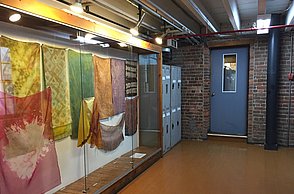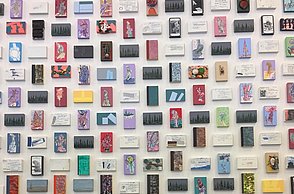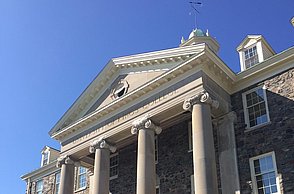Hey, wie geht's? – Nicht nur ein Klischee, sondern die typische Begrüßung in Kanada.
Unser erster Eindruck von den Kanadiern war sehr positiv, sie waren sehr freundlich und offen. Es ist einfach, Kontakte zu knüpfen, Freunde zu finden oder Leute zum Reden zu treffen. Besonders am Anfang hat uns das sehr geholfen, uns wohlzufühlen. Wir wurden sogar von einem kanadischen Studenten eingeladen, Thanksgiving mit ihm und seiner Familie zu feiern. Die Freundlichkeit der Kanadier ist also keineswegs nur ein Klischee! Die Menschen bedanken sich beim Busfahrer, bevor sie aussteigen, halten Fremden die Tür auf und entschuldigen sich, auch wenn sie keine Schuld trifft. Sie entschuldigen sich sogar, wenn jemand mit dem Skateboard an ihnen vorbeifahren will!
Unsere Erwartung von kaltem und verschneitem Wetter in Kanada hat sich bisher nicht erfüllt. Halifax, das direkt am Meer liegt, hat am Ende des Sommers und zu Beginn des Herbstes ein mildes und recht warmes Klima. Lustige Tatsache: Mitte Oktober hat es zufällig ein wenig geschneit, aber nur für etwa fünfzehn Minuten, und dann schien wieder die Sonne.
Studieren an der NSCAD / Kunstszene in Halifax
Mit rund 1000 Studierenden ist die NSCAD University etwas größer als die Designabteilung der Hochschule Pforzheim.
Studierende an der NSCAD beginnen in der Regel mit einem „Foundation Year“, in dem sie einen allgemeinen Überblick über verschiedene Studiengänge erhalten. Danach wählen sie ihr Hauptfach aus vielen Kunststudiengängen oder einem allgemeineren Designstudiengang aus; sie können sich jedoch bis später im Bachelorstudium alle Optionen offenhalten. Im Vergleich zu Pforzheim ist die NSCAD University viel offener, was die Wahl von Kursen aus verschiedenen Studiengängen angeht.
Ein großer Unterschied zu Pforzheim besteht darin, dass die NSCAD den Schwerpunkt auf die Vermittlung von Grundkenntnissen legt, insbesondere in verschiedenen Techniken und Computerprogrammen, was sich in vielen kleineren, arbeitsintensiven Aufgaben während des Semesters zeigt.
Die NSCAD University ist auf drei verschiedene Campusse verteilt, die sich über die gesamte Innenstadt von Halifax erstrecken. Auch wenn man vom Hafen zum Fountain Campus etwa 30 Minuten braucht, hat man zumindest einen schönen Spaziergang entlang der Promenade am Meer.
Halifax hat eine kleine, aber sehr enge Künstlergemeinschaft. Es gibt verschiedene Galerien und viele Ausstellungen und Künstlergespräche. Jeden Montagabend findet in der Galerie der NSCAD („Anna Leonowens Gallery“) eine Vernissage statt. Dabei handelt es sich um eine öffentliche Veranstaltung, bei der sich die Gemeinschaft trifft, um die Arbeiten von Studenten oder Gastkünstlern zu sehen. Die Ausstellungen wechseln jede Woche.
Interdisziplinäres Design – Malin
Designstudenten können frei zwischen vielen verschiedenen Kursen wählen, z. B. Typografie, Fotografie oder Designstudios. Meine Kurse sind Interaktives Design – Grundlagen in HTML und CSS, CAD/CAM-Schmuck & 3D – Entwerfen verschiedener Objekte mit Rhino (auch Schmuck – so cool!), Einführung in Produktdesign und Angewandte Fotografie. Die Aufgaben an der NSCAD unterscheiden sich von denen in Pforzheim hauptsächlich in der Zeit bis zum Abgabetermin; die Studierenden haben mehr Aufgaben, aber weniger Zeit für jede einzelne. Folglich unterscheidet sich auch der Einfluss der Aufgaben auf die Abschlussnote. Auch wenn mir die Vielfalt der verschiedenen Techniken und Grundlagen gefällt, würde ich mir wünschen, mehr Zeit für jedes Fach zu haben, um mich eingehender damit zu beschäftigen.
Textil/Mode – Lisa
Die NSCAD legt einen starken Fokus auf Textilien, weshalb Studierende an der NSCAD nur Textilien als Hauptfach und Mode als Nebenfach belegen können. Daher gibt es dort viel mehr spezifische Textilkurse und -ateliers als in Pforzheim, aber weniger Kurse im Bereich Modedesign. Ich habe Kurse in Weben – auf Webstühlen, Off-Loom-Strukturen – Knoten, Flechten, Drehen, Sprang und verschiedene andere Techniken ohne Webstuhl, Einführung in den Siebdruck – Mischen von Farben mit Pulverfarbstoffen und Pigmenten, Drucken und Entfärben sowie Einführung in das Reservefärben – verschiedene Reserve- und Entfärbungstechniken mit chemischen Farbstoffen wie PRO MX Colors und Säurefarbstoffen sowie natürlichen Farbstoffen besucht. Die Studio-Kurse an der NSCAD sind in der Regel sehr arbeitsintensiv, aber dank einer Vielzahl von Ressourcen und Studios können die Studierenden jede Technik gründlich erlernen. Ich kann die Textilkurse der NSCAD nur wärmstens empfehlen.
Textil/Mode/Bildende Kunst – Tobi
Der Unterrichtsansatz der NSCAD ist sehr schulähnlich: Die Studierenden erhalten jede Woche Hausaufgaben, und die Aufgaben sind nicht sehr flexibel. In einem Semester haben wir viele kleine Projekte in jedem Fach, und wir haben jeweils ein bis drei Wochen Zeit, um sie fertigzustellen. Techniken haben Vorrang vor Konzept und Kreativität. In der Malerei beispielsweise haben wir, um ein besseres Gefühl und Verständnis für Farben und Proportionen zu entwickeln, mit Acrylfarben begonnen und viele Porträts, Stillleben und Kopien gemalt. In der Mitte des Semesters sind wir zu Ölfarben übergegangen. Die Bilder wurden größer und schwieriger. Dadurch habe ich viel über Farben gelernt und darüber, wie man verschiedene Oberflächen richtig darstellt – beispielsweise Früchte, Objekte mit geringer und hoher Farbintensität, Hauttöne sowie glänzende, reflektierende oder durchsichtige Objekte. Alle Einführungskurse in der Textilabteilung sind sehr handwerklich ausgerichtet und haben uns viel über Materialien und Techniken vermittelt, die wir später für unsere eigenen Kollektionen nutzen können.
Das Leben in Halifax
K'jipuktuk, so lautet der Name von Halifax in der Sprache der Mi'kmaq, der Ureinwohner von Nova Scotia und den Maritimes. Halifax ist die Hauptstadt von Nova Scotia. Es ist eine angenehme Stadt, da alles im Zentrum (Downtown und Umgebung) zu Fuß erreichbar ist. Da es in Halifax fünf große Universitäten gibt, leben hier viele junge Menschen. Das Nachtleben ist daher sehr lebhaft, und nach dem Feiern kann man sich sicher zu Fuß fortbewegen. Die Partys enden jedoch recht früh, da Bars und Clubs um 2 Uhr morgens schließen. Das Wichtigste ist aber ohnehin, dass man danach ein Stück Pizza isst.
Leider sind gutaussehende Männer eher selten. Halifax hat eine wunderschöne Promenade entlang des Ozeans, die zu den längsten Kanadas zählt. Die Stadt bietet auch viele Freizeitparks, wie Skateparks und Orte zum Kanufahren. Von Halifax aus sind schöne Orte in ganz Nova Scotia leicht zu erreichen, da die Stadt sehr günstig gelegen ist – besonders im Herbst während des Indian Summer, wenn sich die Blätter in leuchtende Neonrot-, Gelb-, Orange- und Violetttöne verwandeln.
Zu den beliebtesten Speisen gehören Poutine und Hummer – sehr zu empfehlen und sehr lecker!
Warum im Ausland studieren?
Erfahrung! Unserer Meinung nach lernt man immer etwas und wächst an verschiedenen Kulturen und Lehrplänen, egal ob es sich um positive oder negative Erfahrungen handelt.


































